Nestled in the heart of Vienna, St. Stephen's Cathedral (Stephansdom) stands as a testament to architectural brilliance and historical depth. This majestic structure, with its towering spires and intricate details, has been a beacon of Gothic grandeur for centuries. Serving not just as a place of worship, but as a cultural icon, it encapsulates the spirit and resilience of Vienna.
Note: This article contains affiliate links. In case you purchase something through one of these links, we may receive a small commission at no extra cost for you. Thank you for helping us keep creating the free content on this website!
History of St Stephen's Cathedral
St. Stephen's Cathedral, a monumental landmark in Vienna, has a rich history that mirrors the evolution of the city itself. The origins of the site date back two millennia, serving as a burial ground for Romans, showcasing the area's long-standing significance. The construction of the first St. Stephan's Church began in 1137, marking the initial phase of a development that would span centuries. This early establishment laid the groundwork for the architectural marvel that the cathedral would become, symbolizing the beginning of Vienna's spiritual and cultural consolidation.
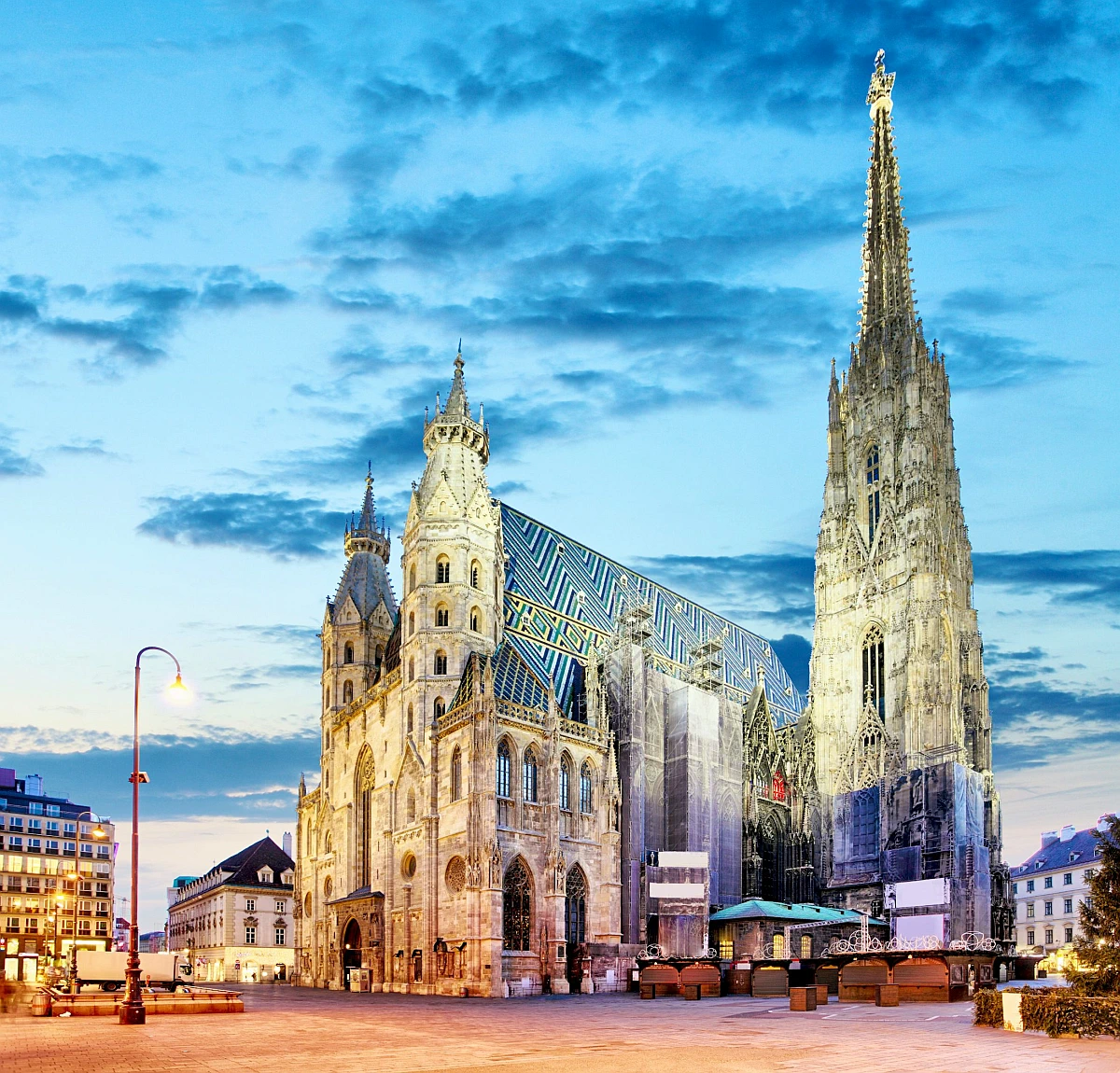
In the early 13th century, the second construction phase of St. Stephen's Cathedral took place, further emphasizing the importance of this religious site in Vienna's urban landscape. Remarkably, sections of that Romanesque structure are still standing today, with the front door, known as the Riesentor or Giant's Door, serving as a poignant reminder of the cathedral's historical and architectural legacy. This continuity provides a tangible link to the past, illustrating the enduring nature of the cathedral's foundational elements.
The year 1258 brought significant adversity to St. Stephen's Cathedral in the form of an enormous fire that coincided with a citywide tragedy. This calamity necessitated considerable restoration efforts for the Catholic church, marking a pivotal moment in its history. The community's response to this disaster reflected the resilience and dedication of Vienna's inhabitants to preserving their iconic cathedral. The restoration work undertaken during this period helped to ensure the survival and continued relevance of St. Stephen's Cathedral as a central place of worship.
Over two hundred years, from 1304 to 1511, St. Stephen's Cathedral underwent its most significant expansion, a testament to the evolving architectural aspirations and the growing importance of the church in the life of the city. The construction of the North Tower, a project that spanned 65 years from 1368 to 1433, exemplifies the complexity and ambition of this expansion phase. The meticulous craftsmanship and dedication required to complete such a monumental task underscore the cathedral's symbolic and physical prominence in Vienna.
Throughout its history, St. Stephen's Cathedral has not been immune to the adversities that have befallen Vienna. From the bubonic plague in 1679 to the Siege of Vienna by Napoleon in 1809 and war damage in 1945, the cathedral has faced numerous challenges. Yet, each crisis was met with a renewal effort, underscoring the cathedral's role as a beacon of hope and resilience. As the mother church of the Archdiocese of Vienna, St. Stephen's Cathedral has continually served as a spiritual center, adapting and enduring through the ages.
The cathedral's significance extends beyond its religious and historical roles, having been a gathering place for world-famous composers such as Joseph Haydn, Wolfgang Amadeus Mozart, and Ludwig van Beethoven. This connection to significant cultural figures further enriches the narrative of St. Stephen's Cathedral, intertwining its history with the broader story of artistic and musical development in Vienna. The legacy of St. Stephen's Cathedral, therefore, is not just one of architectural grandeur and spiritual significance, but also of cultural and historical resonance, reflecting the multifaceted history of Vienna itself.
St. Stephen's Cathedral: A Symbol of Vienna
St. Stephen's Cathedral, standing tall at the heart of Vienna, is not just an architectural masterpiece but a symbol of Austrian heritage and resilience. This majestic cathedral, known locally as Stephansdom, has witnessed the ebb and flow of European history, encapsulating moments of both triumph and turmoil. Its Gothic spires, reaching skyward, serve as a reminder of humanity's quest for the divine, while its intricate stone carvings and stained-glass windows narrate tales from the past, embedding the cathedral's significance deeply into the cultural fabric of Vienna.
Its most recognizable feature, the towering south tower, stands as a testament to the ingenuity of medieval engineering, offering panoramic views of Vienna to those who venture its 343 steps. Over the centuries, St. Stephen's Cathedral has played a pivotal role in the life of the city. It has been a site of royal weddings, a refuge during sieges, and a beacon of hope during times of despair.
Today, St. Stephen's Cathedral continues to be a focal point of cultural and spiritual life in Vienna. It attracts millions of visitors each year, drawn not only to its architectural beauty but also to its historical significance. As a living monument, it hosts regular worship services, concerts, and events that bridge the past with the present. The cathedral, with its resilience and beauty, stands as a symbol of Vienna's enduring spirit, a place where history and heritage are woven into the very stones that have stood the test of time. Through wars, reconstructions, and restorations, St. Stephen's Cathedral has remained a constant in Vienna's skyline, a beacon of faith and tradition in the heart of Austria.
The exterior of the building
Iconic Spire and Rooftop
Dominating the skyline, the cathedral's iconic spire and colorful tiled rooftop are recognizable symbols of Vienna. The rooftop, in particular, with its mosaic of glazed tiles arranged in the pattern of an eagle, symbolizes the city's freedom and strength.
St. Stephen's Cathedral stands as a marvel, its roof a tapestry of vibrant hues and intricate designs, stretching 111 meters (364 ft) under the sky, adorned with 230,000 glazed tiles. Ascending above the choir on the cathedral's southern facade, these tiles weave into the majestic mosaic of the double-headed eagle, a herald of the Habsburg dynasty's realm.
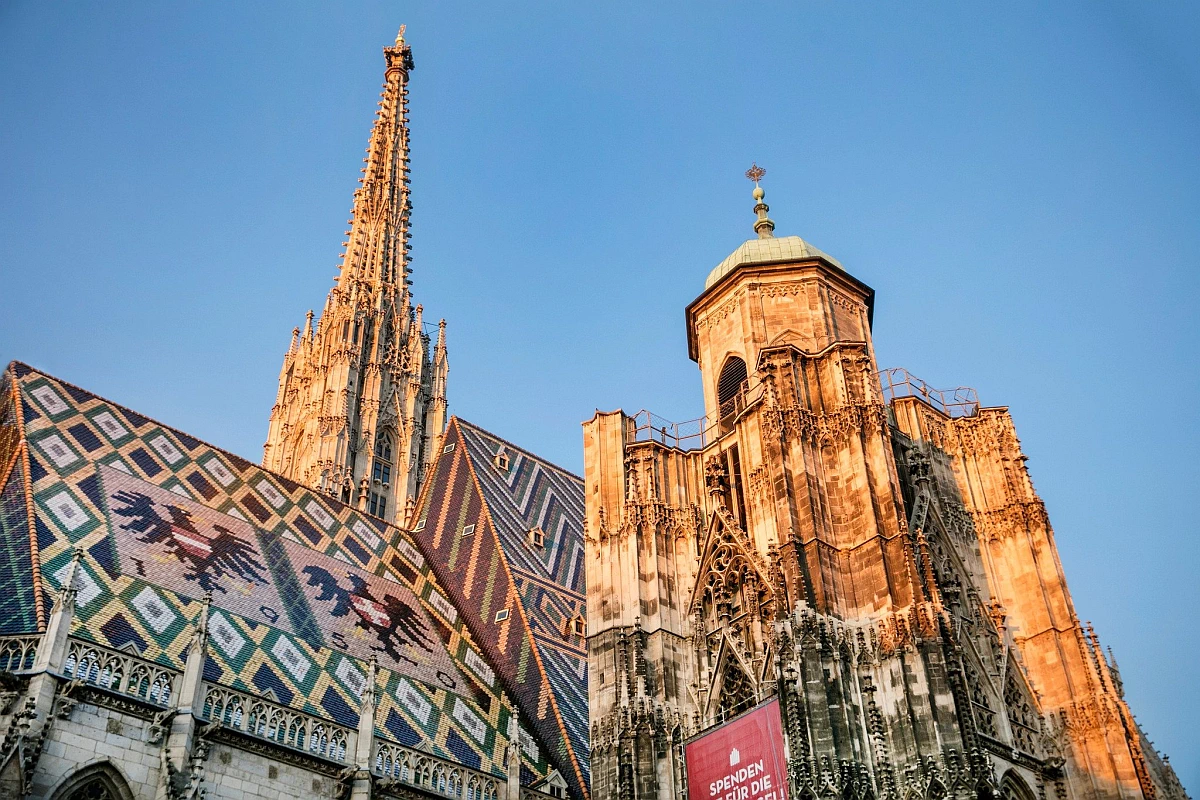
Opposite, on the northern expanse, the emblems of Vienna and the Republic of Austria proudly announce their legacy. The year 1945 witnessed the cathedral's resilience as flames from World War II's devastation sought to claim its north tower, reducing the timber skeleton of its roof to ashes. The original wooden framework, which soared 38 meters above the ground, was irreplaceable without incurring enormous costs.
Thus, a modern twist was embraced with over 600 metric tons of steel providing new strength. Crafted with such precision, the roof's steep incline welcomes the cleansing touch of rain, rarely bearing the weight of snow.
The Towers
Soaring to a height of 136 meters (446 feet), the locals of Vienna warmly call the towering south pinnacle of St. Stephen's Cathedral "Steffl," a charming nickname for "Stephen." This tower, not just a significant part of the city's skyline but also its tallest, was constructed over a period of 65 years, stretching from 1368 to 1433. It played a pivotal role during the 1529 Siege of Vienna and the Battle of Vienna in 1683, acting as the central lookout and command station for protecting the fortified city.
Remarkably, the tower housed an apartment for watchmen who, until the year 1955, would vigilantly monitor the city at night. They were tasked with ringing the tower's bells to alert the city of any fires. Adorning the apex of the tower is the imperial double-eagle symbol, bearing the Habsburg-Lorraine coat of arms, topped with a double-armed apostolic cross. This symbol, denoting the Apostolic Majesty of the Hungarian kings, replaced the previous emblems of a crescent and a six-pointed star. The original emblem, along with several others, is now preserved at the Vienna City Museum.
As for the north tower, it was ambitiously planned to match the grandeur of the south tower. However, this dream was cut short as the era of Gothic cathedrals was drawing to a close, and the construction ceased in 1511. In a twist of fate, in 1578, what remained of the tower was crowned with a Renaissance-style cap, endearingly referred to by the Viennese as the "water tower top." Now, it stands at 68 meters (223 feet) tall, a mere shadow of its intended counterpart, yet a testament to the architectural evolution and the stories etched within the cathedral's walls.
The Giant's Door
Among its many wonders is the Giant's Door (Riesentor), an imposing entrance that captivates visitors with its grandeur and the rich history it symbolizes. This door is not just a physical gateway into the cathedral; it's an entry into the past, offering a glimpse into medieval times when such constructions were feats of engineering and expressions of devotion.
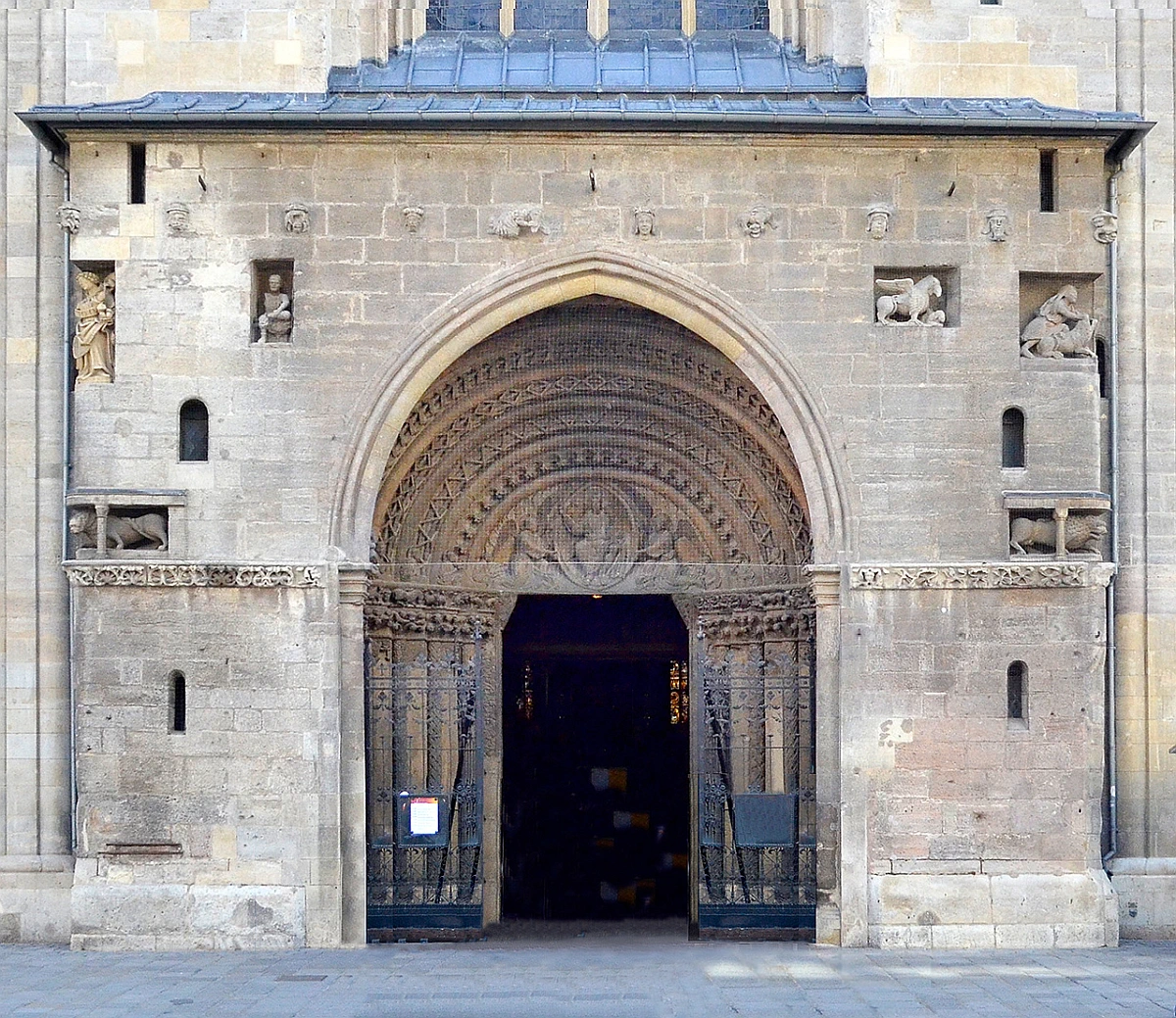
The Giant's Door of St. Stephen's Cathedral is so named not for its association with actual giants, but for its remarkable size and the legendary tales that surround its origin. Crafted in the 13th century, this portal was part of the original Romanesque church, which later gave way to the Gothic magnificence that the cathedral is known for today. The door's name also sparks the imagination with tales of mythical beings and the cathedral's significance as a place of sanctuary and protection for the people of Vienna.
As one stands before the Giant's Door, it's impossible not to feel a sense of awe at the craftsmanship and the centuries of history it has witnessed. The door serves as a testament to the enduring spirit of St. Stephen's Cathedral, enduring wars, restorations, and the passage of time. It invites visitors to step through and explore the wonders within, from its soaring vaults to the intricate stained glass windows, each element telling a story of faith, artistry, and community. The Giant's Door is not just an architectural feature; it's a symbol of the cathedral's role as a beacon of hope and beauty in Vienna's skyline.
The Bells of the St. Stephen's Cathedral
In a moment that would forever define silence for him, Ludwig van Beethoven realized the full extent of his deafness as he watched birds scatter from the bell tower, their flight caused by the ringing bells he could no longer hear.
St. Stephen's Cathedral, home to 22 bells, shelters its largest, the Pummerin, also affectionately known as "Boomer," within the north tower. Weighing a monumental 20,130 kilograms (44,380 lb), it stands as Austria's heaviest bell and Europe's second-largest that swings, only surpassed by the Peter bell in Cologne Cathedral at 23,500 kilograms (51,800 lb).
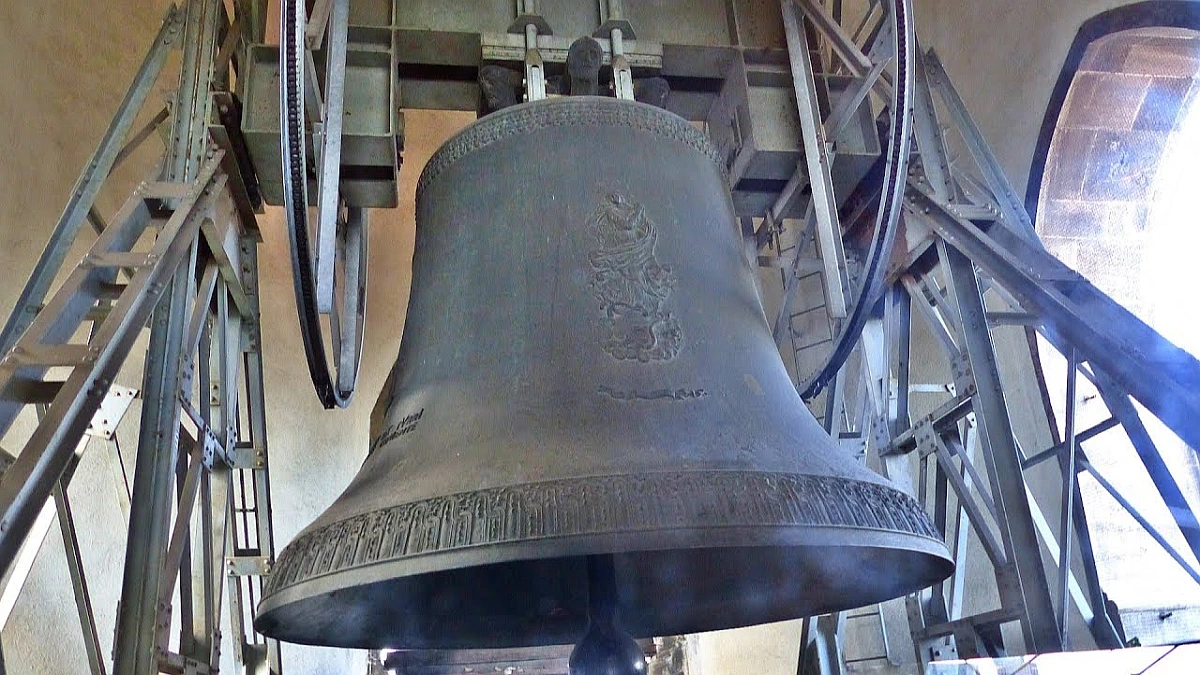
Forged in 1711 by Johann Achammer using cannons seized from Muslim forces, the Pummerin was reborn in 1951 from the ashes of its predecessor, which plummeted to the ground during a fire in 1945. This rebirth, incorporating original metal, resulted in a bell with a 3.14-meter (10.3 ft) diameter, a gift from Upper Austria, resonating only during momentous events such as the New Year. The north tower also houses two historical bells, the Kleine Glocke and the Speisglocke, alongside the Zügenglocke, with the Kleine Glocke recently returning to service after restoration.
Below, the south tower stands tall with a newer set of eleven electric bells, cast in 1960 to replace those lost in the 1945 tragedy. These bells, each named after saints, serve the cathedral's liturgical life, with the number used varying from four during ordinary Mass to all eleven for significant ceremonies, especially when graced by the Cardinal Archbishop of Vienna. The largest among them, the St. Stephen bell, leads this celestial choir.
The north Roman Tower houses a sextet of bells, four cast in 1772, that signal evening prayers and mark the cathedral's funerals. These bells, each with a unique name and story, like the Feuerin, now calling the faithful to evening prayers instead of its original alarm service, and the Poor Souls bell, dedicated to funeral rites, embody the cathedral's rich history and its community's spiritual life.
Sadly, the 1945 blaze claimed the lives of the bells in the south Roman Tower, a loss that resonates with the silence Beethoven experienced, a poignant reminder of beauty and history that endures beyond the reach of sound.
Exploring the Interior
Exploring the interior of St. Stephen's Cathedral, is akin to stepping into a realm where history and spirituality intertwine. As you wander through its vast nave, the intricate stained glass windows cast a kaleidoscope of light across the stone floors, illuminating the cathedral's ornate altars and the richly carved pulpit. The air carries a sense of reverence, punctuated by the occasional echo of footsteps or the distant melody of the organ.
Each corner of the cathedral, from the solemn catacombs below to the towering spire that punctures the skyline, tells a story of faith, artistry, and the resilience of a community that has cherished and preserved this sacred space through centuries of turmoil and triumph.
The Altarpieces
Within the cathedral's walls lie altarpieces that are masterpieces of religious art. These works, rich in symbolism and emotion, tell the stories of saints and sages, inviting onlookers into a deep reflection on faith and humanity. Nestled within the heart of the church, a grand total of 18 altars stand majestically, with additional altars scattered across its numerous chapels. Among these, the High Altar and the Wiener Neustadt Altar rise as the crown jewels.
The journey through the church invariably leads visitors to the awe-inspiring High Altar, a masterpiece crafted over a span of seven years, from 1641 to 1647, marking the cathedral's inaugural venture into the baroque era. Crafted under the watchful eye of Tobias Pock, following the vision of Vienna's Bishop Philipp Friedrich Graf Breuner, the altar is a symphony in marble sourced from the depths of Poland, Styria, and Tyrol. It stands as a monument to the martyrdom of St. Stephen, the church's guardian, encircled by the venerable figures of local saints - Leopold, Florian, Sebastian, and Rochus. Above, a statue of St. Mary reaches skyward, guiding the gaze to a celestial realm where Christ awaits Stephen's ascent.
The Wiener Neustädter Altar, presiding over the north nave, tells a story of imperial ambition and ecclesiastical change. Commissioned in 1447 by Emperor Frederick III, whose final resting place lies nearby, this altar originally adorned the Cistercian Viktring Abbey. It bears the emperor's cryptic A.E.I.O.U. motto, symbolizing his intent and vision. The altar survived the closure of its first home in 1786, amidst Emperor Joseph II's dissolution of monastic orders, finding refuge first in the Cistercian monastery at Wiener Neustadt, then finally making its way to St. Stephen's Cathedral in 1885, following the monastery's merger and closure.
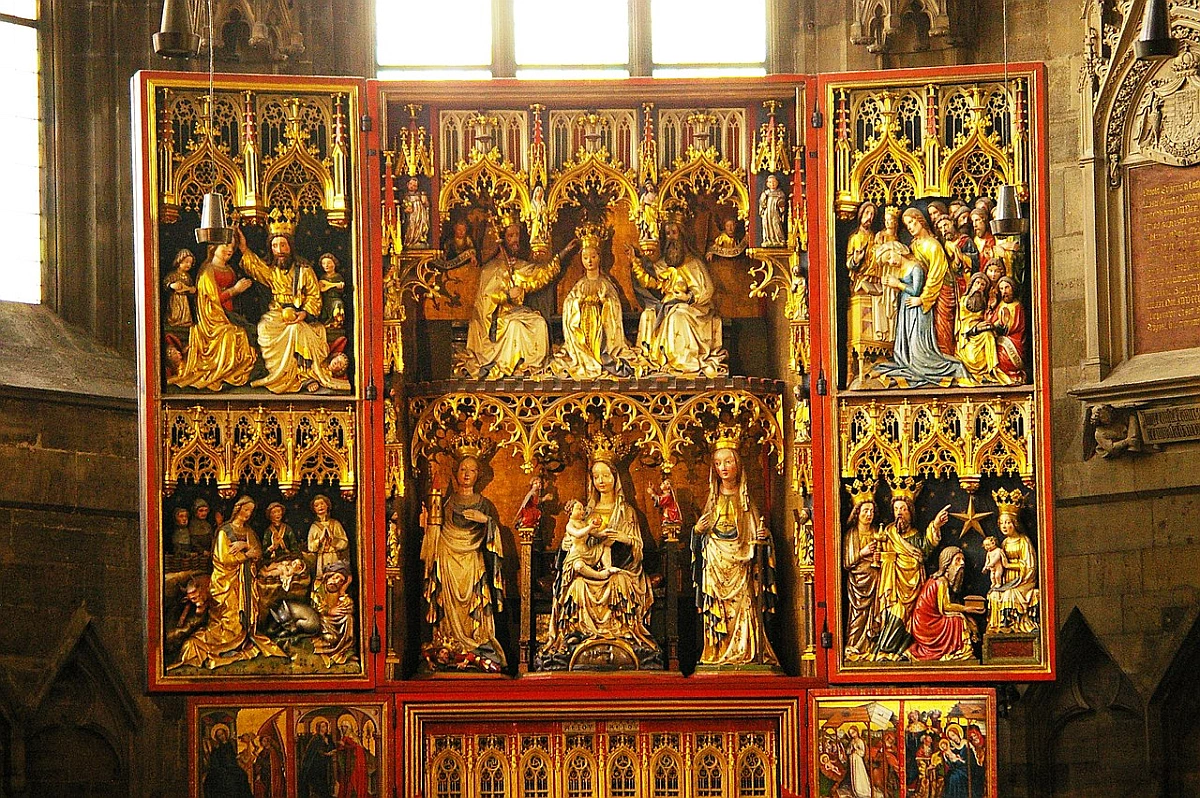
This remarkable altar, a dual-layered triptych, reveals a hidden complexity; its lower section, modest beside the towering upper panels, conceals a Gothic grate, once a reliquary depot. During the week, the altar's somber painted panels hide its splendor, showcasing 72 saints in muted tones. Yet, come Sunday, it blossoms into a vibrant display of gilded wooden figures, each telling tales from the Virgin Mary's life. A century after its arrival at the cathedral, a painstaking 20-year restoration began, demanding the dedication of 10 art restorers, 40,000 man-hours, and a budget of €1.3 million to revive its 100 square metres of intricate artistry.
The Pulpit
Nestled within the hallowed halls of late Gothic artistry, the stone pulpit stands as a testament to the era's sculptural genius. Initially credited to Anton Pilgram, the tides of time now favor Niclaes Gerhaert van Leyden as the likely artisan behind this masterpiece. Positioned strategically against a pillar in the nave, rather than the conventional chancel forefront, this design choice amplifies the sermon's reach in an age untouched by the technological advances of microphones and loudspeakers.
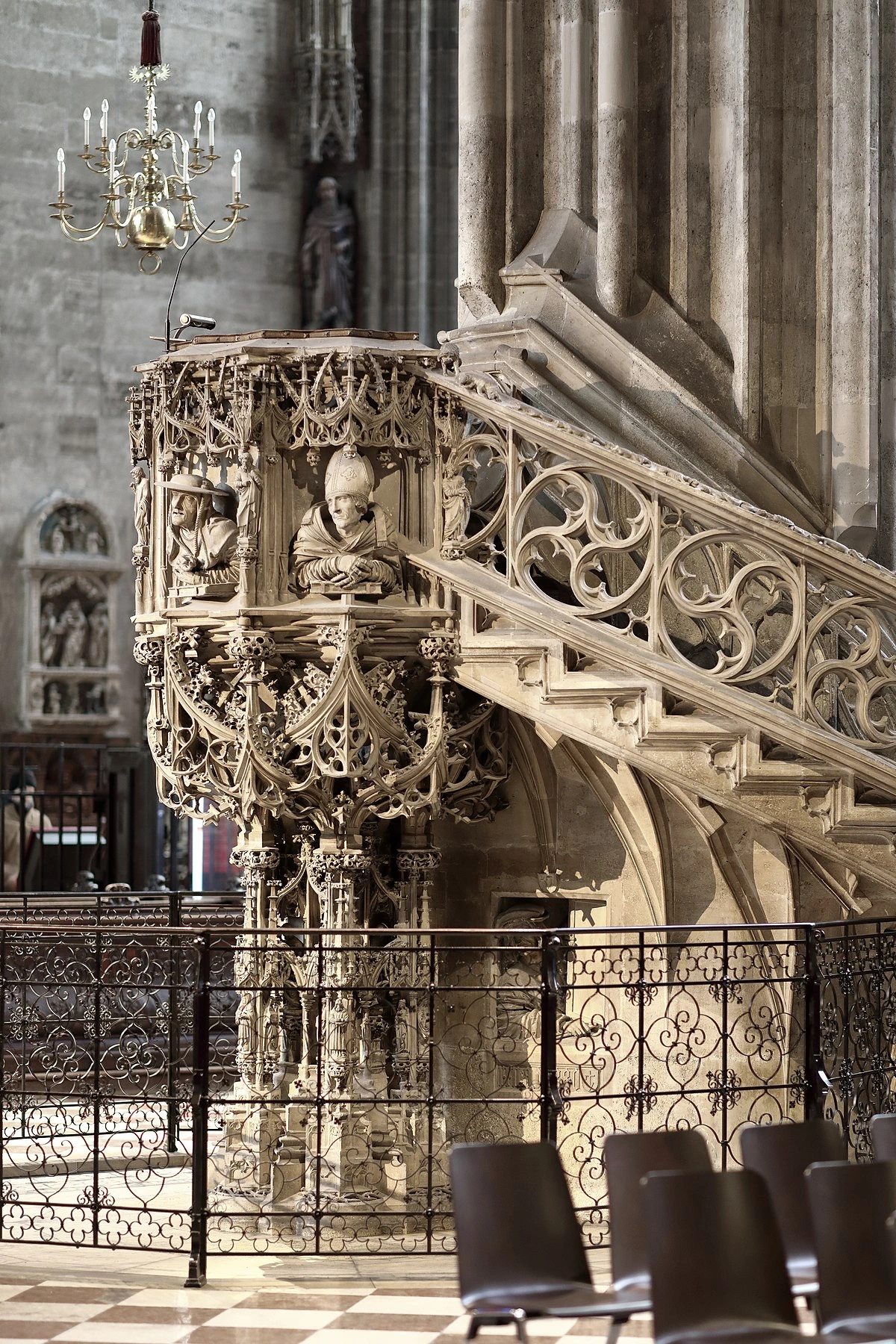
Emerging from its supporting stem, the pulpit's sides unfold in a display of Gothic elegance, mimicking the bloom of stylized petals. Adorning these petals are the relief portraits of the Church's venerable Doctors - St. Augustine of Hippo, St. Ambrose, St. Gregory the Great, and St. Jerome. Each figure is captured in a distinct temperament and phase of life, crafting a narrative of spiritual depth and diversity. The stairway's handrail, which snakes around the pillar to the pulpit, is a spectacle of gothic fantasy, showcasing a dramatic interplay of toads and lizards entwined in an eternal battle of good versus evil. At the stairwell's summit, a stone canine stands guard, a whimsical protector against any who dare intrude.
Hidden beneath this ascension lies a cherished emblem of the cathedral's lore: a stone sculptor, caught in a moment of curious observation from a window alcove, earning the moniker Fenstergucker. The presence of a chisel and a mason's mark above the window whispers tales of a possible self-portrait, adding layers of mystery and personal connection to this enigmatic figure's creation.
The Chapels
Within the venerable walls of St. Stephen's Cathedral, a constellation of chapels each tells a story, a silent testament to centuries of faith and artistry:
- Nestled at the south tower's base, St. Catherine's Chapel serves as a sacred space for baptisms. Its unique 14-sided font, finalized in 1481, boasts a cover that once amplified the voices from the renowned pulpit. The marble foundation is adorned with the likenesses of the four Evangelists, and the basin's niches are a gallery of the twelve apostles, Christ, and St. Stephan, watching over the sacrament of new beginnings.
- St. Barbara's Chapel, rooted in the north tower's foundation, invites a journey inward, offering a sanctuary for meditation and prayer, a quiet corner for reflection amidst the cathedral's grandeur.
- Tucked in the southeast corner, St. Eligius's Chapel stands open for prayer, home to an altar venerating St. Valentine. Intriguingly, this chapel houses one of the three known bodies of St. Valentine, with its final resting place a mystery held upstairs.
- Ascend to discover St. Bartholomew's Chapel, perched above St. Eligius' Chapel, freshly revived from restoration, it whispers tales of resilience and renewal.
- The Chapel of the Cross (PES), located in the northeast corner, guards the final resting place of Prince Eugene of Savoy. Beneath a hefty stone slab, marked by iron rings, lie three coffins and a heart urn, the chapel's air heavy with history. It was here, on December 6, 1791, that Mozart was mourned. The crucified Christ that presides over the chapel dons a beard of real hair, a detail as peculiar as it is captivating, though its doors remain closed to the public gaze.
- Lastly, St. Valentine's Chapel, resting above the Chapel of the Cross, houses the cathedral's vast collection of relics, including a fragment of the Last Supper's tablecloth. A large chest cradles the bones of St. Valentine, relocated here roughly a century ago from what is now the Chapter House, south of the High Altar, safeguarding a piece of history, of love, of faith.
Tombs, catacombs, and crypts
From its inception, the cathedral has been a final resting place, cradled by graveyards that whisper tales from Roman epochs. It has been a mark of distinction to lie in eternal rest within its sacred walls, in proximity to the saints and their revered relics. Those not afforded this honor found their place in the earth's embrace just beyond the sanctuary's embrace.
Within its hallowed interior rest individuals of historic renown, such as Prince Eugene of Savoy, the illustrious leader of the Imperial forces in the War of the Spanish Succession, his tomb nestled within the Chapel of The Cross. Nearby, in the Apostles' Choir, lies Frederick III, the Holy Roman Emperor under whose rule the Diocese of Vienna was established, marking a pivotal moment in history on the 18th of January, 1469.
The endeavor to construct Emperor Frederick's final resting place was a monumental task, extending over 45 years, a testament to the era's dedication to honoring their leaders. The sarcophagus, a marvel of red marble-like stone from Adnet quarry and crafted by Niclaes Gerhaert van Leyden, portrays the emperor in his regal attire, encircled by the insignias of his realm. This tomb, adorned with 240 statues, stands as a monumental piece of medieval artistry.
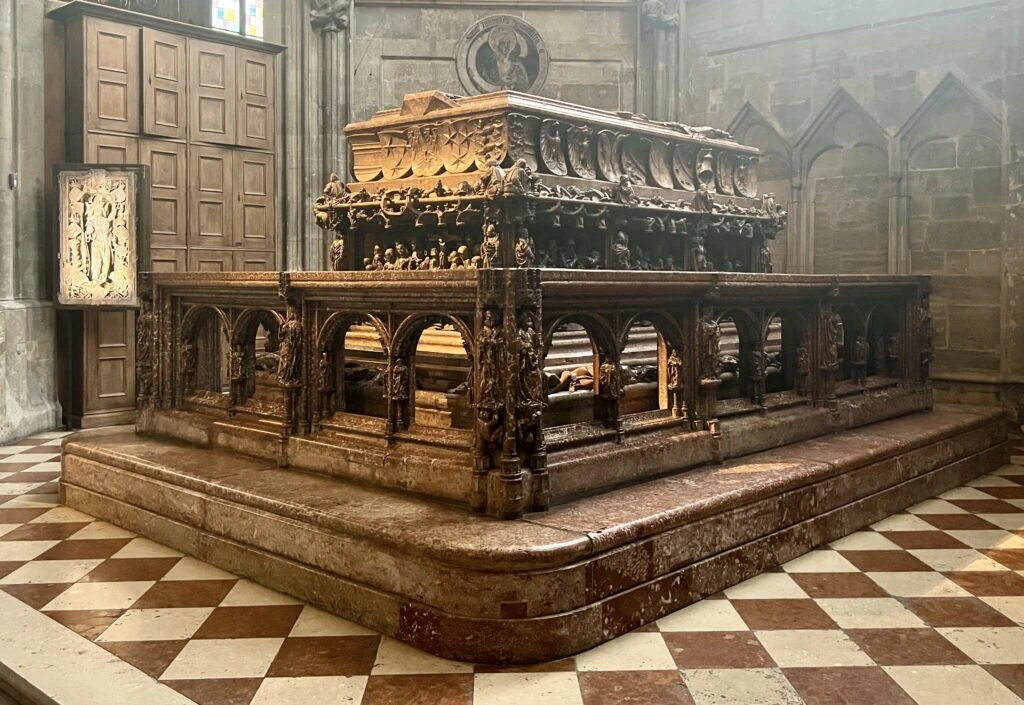
A turning point came in 1735 when, following a bubonic plague outbreak, the cathedral's adjacent charnel house and cemeteries were closed, and the remains within were transferred to the catacombs beneath. This underground sanctuary housed the remains of over 11,000 souls until 1783, when new regulations halted most burials within the city's confines, marking the end of an era.
Beneath the cathedral's solemn nave, the crypts of Bishops, Provosts, and Dukes offer a silent testimony to the cathedral's role as a custodian of history. The most recent to join this eternal congregation was Cardinal Franz König, interred in the Bishop's crypt in 2004 at the age of 98. Nearby, the Provosts rest in their designated chamber, while a special section at the Zentralfriedhof holds other cathedral dignitaries.
The Ducal Crypt, hidden under the chancel, safeguards the remains of the Habsburg dynasty in 78 bronze vessels. Commissioned by Duke Rudolf IV before his demise in 1365, this crypt was expanded over the centuries to accommodate the increasing number of sarcophagi and urns. A significant renovation in 1956 reorganized its contents, ensuring the legacy of Duke Rudolf IV and his consort are prominently displayed, surrounded by the history they helped shape.
Organs of the St. Stephen's Cathedral
Nestled within the venerable walls of St Stephen's Cathedral, an illustrious tradition of organ music whispers through the ages, tracing back to its first organ, heralded in 1334. The tapestry of time saw its renewal amidst the ashes of 1945 when Michael Kauffmann, fueled by the generosity of public contributions, birthed a monumental electric action pipe organ in 1960, boasting 125 stops across 4 manuals. The journey of rejuvenation continued in 1991, with the Austrian craftsmen from Rieger infusing new life into the choir organ, rendering it a mechanical marvel of 56 voices and 4 manuals.
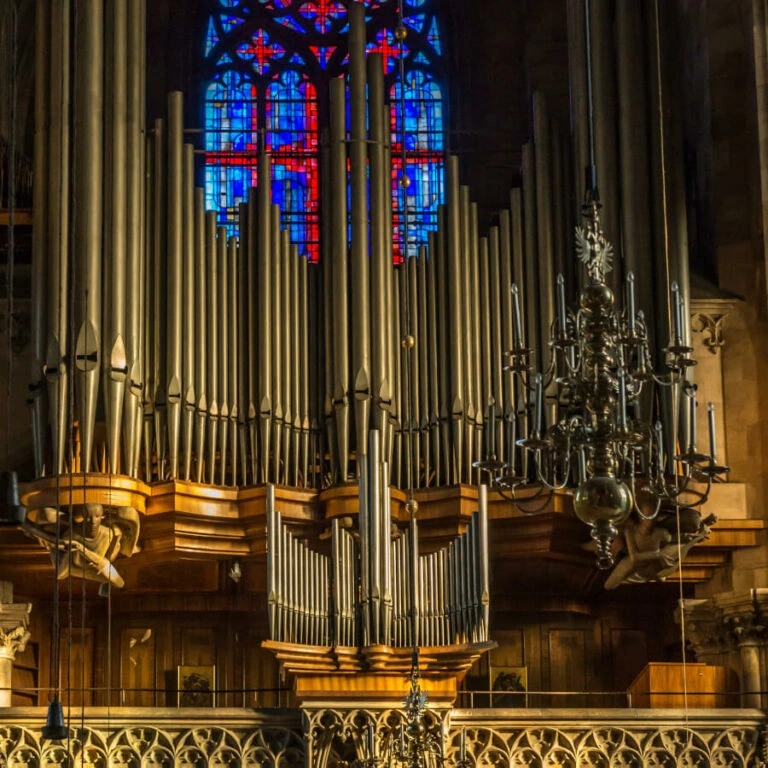
The narrative took a turn when the Kauffmann organ, after resonating at the west end for a mere 35 years, succumbed to silence. Yet, resilience spoke in 2017-2020, as Rieger once again stepped in to weave the old with the new. They revitalized the west end (Riesenorgel) organ, marrying the facade from 1960 with heritage pipework, to unveil an organ of 5 manuals and 130 stops. A novel console, conceived between 2017 and 2020, emerged as a conductor's dream, orchestrating a symphony with 185 stops across 5 manuals, enabling the Riesenorgel and choir organ to sing in unison. Beyond these giants, the Cathedral shelters 3 smaller instruments, each a testament to the enduring legacy of St Stephen's organ tradition.
Tips and Tricks for visitors
- Check Opening Hours: Before you go, check the cathedral's current opening hours as they can vary, especially during religious holidays or special events.
- Guided Tours: Consider joining a guided tour to gain deeper insights into the cathedral's history, architecture, and art. There are different tours available, including the catacombs, towers, and the treasury.
- Since St. Stephen's Cathedral is a place of worship, dress modestly out of respect. Shoulders and knees should be covered.
- The South Tower offers breathtaking views of Vienna. Be prepared for a workout, though, as there are 343 steps and no elevator. The effort is well worth it for the panoramic views.
- A tour of the catacombs is a must for history enthusiasts. These underground chambers serve as the final resting place for many notable figures and contain remnants of the city's medieval past. Note that photography might be restricted.
- The cathedral's roof, covered with colorful tiles arranged in intricate patterns, is a work of art in itself. Some tours offer access to areas where you can get a closer look.
- Experiencing a service or a concert at St. Stephen's Cathedral can be a moving experience, regardless of your religious beliefs. Check the cathedral's schedule for mass times and concert dates.
- Early mornings or late afternoons offer the best light for photography, with fewer people around. Be mindful of no-photo zones and the use of flash inside the cathedral.
- Parts of the cathedral are accessible to visitors with mobility issues, but due to its historic nature, not all areas are easily accessible. Check ahead for specific accessibility information.
- The area around Stephansdom is rich with Viennese culture, from cafes where you can enjoy a traditional Viennese coffee to shops selling local crafts.
FAQs about St. Stephen's Cathedral
What is the best time to visit St Stephen's Cathedral to avoid crowds?
The best time to visit St Stephen's Cathedral to avoid crowds is early in the morning on weekdays or later in the evening before closing. These times tend to be quieter, allowing for a more peaceful exploration of the cathedral. Visiting outside of peak tourist seasons (spring and autumn) can also help avoid large groups.
How can I contribute to the preservation of St Stephen's Cathedral?
Contributions to the preservation of St Stephen's Cathedral can be made through donations, either directly at the cathedral or via its official website. There are often specific restoration projects and programs that welcome financial support. Volunteering for events or educational programs is another way to contribute to its preservation.
Are there any guided tours available, and what do they cover?
Yes, guided tours are available at St Stephen's Cathedral. These tours cover the cathedral's rich history, architectural details, and significant artworks. Specialized tours may focus on specific aspects, such as the rooftop, the crypts, or the cathedral's musical history. Check the official website for schedules and themes.
What is the significance of the cathedral's rooftop design?
The cathedral's rooftop is renowned for its colorful tilework, creating a mosaic that includes the coat of arms of the city of Vienna and the Republic of Austria. This design is not only a significant architectural feature but also symbolizes the cathedral's cultural and historical importance to Vienna and Austria as a whole.
Can visitors access the crypts, and what can they expect to see?
Visitors can access the crypts through guided tours, which offer a glimpse into the cathedral's history beneath the surface. The crypts house the tombs of notable historical figures, ecclesiastical treasures, and relics. The experience provides a unique insight into the centuries-old history of Vienna and its cathedral.
What events and concerts are held at St Stephen's Cathedral throughout the year?
St Stephen's Cathedral hosts a variety of events and concerts throughout the year, celebrating both religious ceremonies and cultural performances. These include classical music concerts, choir performances, and special holiday services. The cathedral's acoustics and atmosphere make it a sought-after location for such events. For a current schedule, it's best to consult the official website or local event listings.
Conclusion
St. Stephen's Cathedral is more than just a building; it is a symbol of Vienna's heart and soul. Its Gothic grandeur and historical depth make it a must-visit for anyone seeking to understand the spirit of this remarkable city. As a beacon of faith, art, and community, it stands as a testament to the enduring power of beauty and belief.
Site location: Stephansplatz 3, 1010 Wien
GPS coordinates: 48.208147, 16.373953
Google Photos: Click here
Did you find our article interesting? We have good news, as we will be constantly updating the content on our website. If you want to know all about Europe's big cities, follow our column by clicking here!















